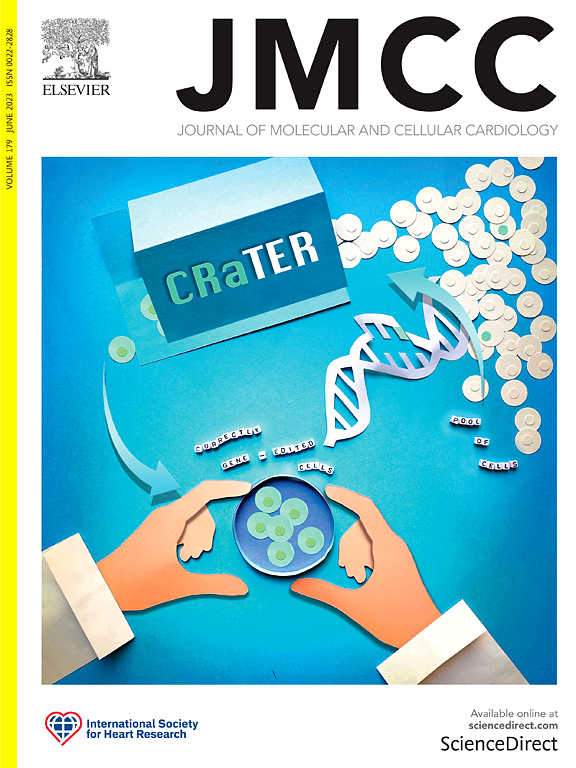Stochastic and alternating pacing paradigms to assess the stability of cardiac conduction
IF 4.9
2区 医学
Q1 CARDIAC & CARDIOVASCULAR SYSTEMS
引用次数: 0
Abstract
Reentry, the most common cause of severe arrhythmias, is initiated by slow conduction and conduction block. Hence, evaluating conduction velocity and conduction block is of primary importance. However, the assessment of cardiac conduction safety in experimental and clinical settings remains elusive. To identify markers of conduction instability that can be determined experimentally, we developed an approach based on new pacing paradigms. Conduction across a cardiac tissue expansion was assessed in computer simulations and in experiments using cultures of neonatal murine cardiomyocytes on microelectrode arrays. Simulated and in vitro tissues were paced at a progressively increasing rate, with stochastic or alternating variations of cycle length, until conduction block occurred. Increasing pacing rate led to conduction block near the expansion. When stochastic or alternating variations were introduced into the pacing protocol, the standard deviation and the amplitude of alternating variations of local conduction times emerged as markers of unstable conduction prone to block. In both simulations and experiments, conduction delays were prolonged at the expansion but increased only slightly during the pacing protocol. In contrast, these markers of instability increased several-fold, early before block occurrence. The first and second moments of these two metrics provided an estimation of the site of block and the accuracy of this estimation. Therefore, when beat-to-beat variations of pacing cycle length are introduced into a pacing protocol, the local variability of conduction permits to predict sites of block. Our pacing paradigms may have translational applications in clinical cardiac electrophysiology, particularly in identifying ablation targets during mapping procedures.

评估心脏传导稳定性的随机和交替起搏范例。
再通是导致严重心律失常的最常见原因,由缓慢传导和传导阻滞引起。因此,评估传导速度和传导阻滞至关重要。然而,在实验和临床环境中对心脏传导安全性的评估仍然难以捉摸。为了找出可通过实验确定的传导不稳定性标志物,我们开发了一种基于新起搏范式的方法。在计算机模拟和使用微电极阵列上的新生小鼠心肌细胞培养实验中,我们评估了心脏组织扩张时的传导情况。模拟和体外组织的起搏频率逐渐增加,周期长度随机或交替变化,直至发生传导阻滞。起搏频率的增加会导致扩张附近的传导阻滞。在起搏方案中引入随机或交替变化时,局部传导时间交替变化的标准偏差和振幅成为容易发生传导阻滞的不稳定传导的标志。在模拟和实验中,传导延迟在扩容时延长,但在起搏方案中仅轻微增加。与此相反,这些不稳定的标志物在阻滞发生前的早期增加了数倍。这两个指标的第一矩和第二矩提供了对阻滞部位的估计以及这种估计的准确性。因此,在起搏方案中引入起搏周期长度的逐次变化时,传导的局部变化可预测阻滞部位。我们的起搏范式可能会在临床心脏电生理学中得到转化应用,尤其是在制图过程中确定消融目标方面。
本文章由计算机程序翻译,如有差异,请以英文原文为准。
求助全文
约1分钟内获得全文
求助全文
来源期刊
CiteScore
10.70
自引率
0.00%
发文量
171
审稿时长
42 days
期刊介绍:
The Journal of Molecular and Cellular Cardiology publishes work advancing knowledge of the mechanisms responsible for both normal and diseased cardiovascular function. To this end papers are published in all relevant areas. These include (but are not limited to): structural biology; genetics; proteomics; morphology; stem cells; molecular biology; metabolism; biophysics; bioengineering; computational modeling and systems analysis; electrophysiology; pharmacology and physiology. Papers are encouraged with both basic and translational approaches. The journal is directed not only to basic scientists but also to clinical cardiologists who wish to follow the rapidly advancing frontiers of basic knowledge of the heart and circulation.

 求助内容:
求助内容: 应助结果提醒方式:
应助结果提醒方式:


